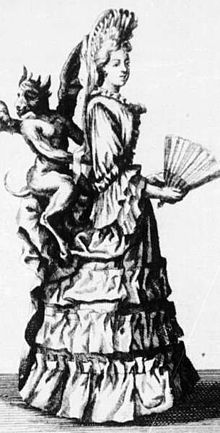Cul de Paris
The term Cul de Paris (pronounced: ky də paʀi ; French Pariser butt ; also cul de ouatte 'Wattehintern' or cul de la pure 'Queen's butt '; in German - for example Mannheim dialect - also corrupted to Kidebari (e) ) denotes one Silhouette of female fashion that appeared several times in the course of costume history and was characterized by a strong emphasis / overemphasis on the rear. It is not clear where the reference to Paris comes from. Perhaps the inventor wanted to suggest in a satirical way that only big city dwellers can fall for such extreme fashions, which contemporaries often find ridiculous.
The first cul de Paris around 1700 puffed up the manteau . Substructures under the skirt had been used before to change the silhouette (see hoop skirt , woman's bacon ), but around 1700 the bulge shifted backwards.
The second cul de Paris developed from 1772 parallel to the robe à la polonaise , which owed its special silhouette partly to the upholstery and partly to the skirt that was puffed out at the back. It was later also worn with the robe à l'anglaise . This fashion lasted until around 1780.
In the late 19th century, the Cul de Paris returned twice in quick succession, namely 1872–1876 and 1882–1886. After the rock pillar that was used at that time, it's called these two fashion silhouettes and first and second bustle .
In each of these cases, this fashion was largely limited to the wealthy classes.
Cul de Paris with Manteau and Fontange (approx. 1685–90)
Web links
literature
- Elisabeth Goriup: Women's fashion: from hoop skirts to cul de Paris , Landesmuseum Joanneum (1974)
- From tour to cul de Paris: Viennese women's fashion from 1868 to 1888 ; in the showroom of the fashion collection, Vienna, Schloss Hetzendorf, May 6, 1993 to April 10, 1994; Museums of the City of Vienna, 1993.
Individual evidence
- ↑ Eduard Beer: The latest foreign dictionary for the Germanization and explanation of all non-German words, idioms, art expressions and abbreviations that occur in language and writing: With constant indication of their emphasis, pronunciation and ancestry, as well as the gender of the nouns. L - Z . Voigt, 1838, p. 560.
- ↑ Ellen Dorothea Johanna Brodersen Andersen: Moden i 1700-årene . National-museet, January 1, 1977, ISBN 978-87-480-0123-7 , p. 105.
- ↑ Sonja Steiner-Welz: 400 years of the city of Mannheim (documents on city history). Volume 2: from the imperial era to 1918 . Reinhard Welz Vermittler Verlag eK,, ISBN 978-3-936517-46-0 , p. 177.
- ^ Fiesko on Genoa. Cabale and Love: 3: Theater2 . bey Franz Ludwig, 1825, p. 394.




